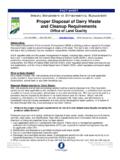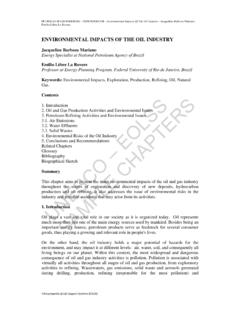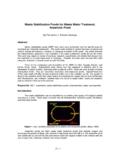Transcription of Environmental Protection Agency Wastewater Technology …
1 United StatesEnvironmental ProtectionAgencyWastewater Technology Fact SheetAnaerobic LagoonsDESCRIPTIONAn anaerobic lagoon is a deep impoundment,essentially free of dissolved oxygen, that promotesanaerobic conditions. The process typically takesplace in deep earthen basins, and such ponds are usedas anaerobic pretreatment systems. anaerobic lagoons are not aerated, heated, or typical depth of an aerated lagoon is greater thaneight feet, with greater depths preferred. Such depthsminimize the effects of oxygen diffusion from thesurface, allowing anaerobic conditions to prevail. Inthis respect, anaerobic lagoons are different fromshallower aerobic or facultative lagoons, making theprocess analogous to that experienced with a single-stage unheated anaerobic digester, except thatanaerobic lagoons are in an an open earthen , conventional digesters are typically usedfor sludge stabilization in a treatment process, whereaslagoons typically are used to pretreat raw includes separation of settlable solids,digestion of solids, and treatment of the liquid lagoons are typically used for two majorpurposes.
2 1) pretreatment of high strength industrial ) pretreatment of municipal Wastewater to allowpreliminary sedimentation of suspended solids as apretreatment lagoons have been especially effective forpretreatment of high strength organic include industrial wastewaters and ruralcommunities that have a significant organic load fromindustrial sources. Biochemical oxygen demand(BOD) removals up to 60 percent are possible. Theeffluent cannot be discharged due to the high level ofanaerobic byproducts remaining. anaerobic lagoonsare not applicable to many situations because of largeland requirements, sensitivity to environmentalconditions, and objectionable odors.
3 Furthermore, theanaerobic process may require long retention times,especially in cold climates, as anaerobic bacteria areuneffective below 15 C. As a result, anaerobiclagoons are not widely used for municipal wastewatertreatment in northern parts of the United anaerobic lagoon is a deep earthen basin withsufficient volume to permit sedimentation of settlablesolids, to digest retained sludge, and to anaerobicallyreduce some of the soluble organic substrate. Rawwastewater enters near the bottom of the pond andmixes with the active microbial mass in the sludgeblanket. anaerobic conditions prevail except for ashallow surface layer in which excess undigestedgrease and scum are concentrated.
4 Sometimesaeration is provided at the surface to control impervious crust that retains heat and odors willdevelop if surface aeration is not provided. Thedischarge is located near the side opposite of theinfluent. The effluent is not suitable for discharge toreceiving waters. anaerobic lagoons are followed byaerobic or facultative lagoons to provide anaerobic lagoon is usually preceded by a barscreen and can have a Parshall flume with a flowrecorder to determine the inflow to the lagoon . Acover can be provided to trap and collect the methanegas produced in the process for use elsewhere, but thisis not a common microorganisms in the absence of dissolvedoxygen convert organic materials into stable productssuch as carbon dioxide and methane.
5 The degradationprocess involves two separate but interrelated phases:acid formation and methane the acid phase, bacteria convert complexorganic compounds (carbohydrates, fats, and proteins)to simple organic compounds, mainly short-chainvolatile organic acids (acetic, propionic, and lacticacids). The anaerobic bacteria involved in this phaseare called acid formers, and are classified asnonmethanogenic microorganisms. During this phase,little chemical oxygen demand (COD) or biologicaloxygen demand (BOD) reduction occurs, because theshort-chain fatty acids, alcohols, etc., can be used bymany microorganisms, and thereby exert an oxygendemand. The methane-production phase involves anintermediate step.
6 First, bacteria convert the short-chain organic acids to acetate, hydrogen gas, andcarbon dioxide. This intermediate process is referredto as acetogenesis. Subsequently, several species ofstrictly anaerobic bacteria (methanogenicmicroorganisms) called methane formers convert theacetate, hydrogen, and carbon dioxide into methanegas (CH4) through one of two major pathways. Thisprocess is referred to as methanogenesis. During thisphase, waste stabilization occurs, represented by theformation of methane gas. The two major pathways ofmethane formation are:1) The breakdown of acetic acid to form methane andcarbon dioxide:CH3 COOH CH4 + CO22) The reduction of carbon dioxide by hydrogen gasto form methane:CO2 + 4H2 CH4 + 2 H20 EquilibriumWhen the system is working properly, the two phasesof degradation occur simultaneously in dynamicequilibrium.
7 That is, the volatile organic acids areconverted to methane at the same rate that they areformed from the more complex organic growth rate and metabolism of the methanogenicbacteria can be adversely affected by small fluctuationsin pH substrate concentrations, and temperature, butthe performance of acid-forming bacteria is moretolerant over a wide range of conditions. When theprocess is stressed by shock loads or temperaturefluctuations, methane bacteria activity occurs moreslowly than the acid formers and an imbalance volatile organic acids accumulate and thepH drops. As a result, the methanogens are furtherinhibited and the process eventually fails withoutcorrective action.
8 For this reason, the methane-formation phase is the rate-limiting step and must notbe inhibited. For the design of an anaerobic lagoon towork, it must be based on the limiting characteristics ofthese and maintaining equilibriumThe system must operate at conditions favorable for theperformance of methanogenic bacteria. Ideally,temperatures should be maintained within the range of25 to 40 C. anaerobic activity decreases rapidly attemperatures below 15 C , when water temperaturedrops below freezing, and biological activity virtuallyceases. The pH value should range from to ,but should not drop below because methanebacteria cannot function below this level. Suddenfluctuations of pH will inhibit lagoon should range from 1,000 to 5,000 mg/L.
9 Volatile acid concentration is an indicator of processperformance because the acids are converted tomethane at the same rate that they are formed ifequilibrium is maintained. Volatile acid concentrationswill be low if the lagoon system is working a general rule, volatile acid concentrations shouldbe less than 250 mg/L. Inhibition occurs at volatileacid concentrations in excess of 2,000 mg/L. Table 1presents optimum and extreme operating ranges formethane formation. The rate of methane formationdrops dramatically outside these extreme ranges. Inaddition to adhering to the above guidelines, sufficientnutrients such as nitrogen and phosphorus must beavailable. Concentrations of inhibitory substances,including ammonia and hydrogen when a highconcentration of sulfate ions are present, andconcentrations such as calcium, should be kept to aminimum.
10 Excessive concentrations of these inhibitorsproduce toxic effects. Depending on its form, ammoniacan be toxic to the bacteria as well as affect itsconcentration. Concentration of free ammonia inexcess of 1,540 mg/L will result in severe toxicity, butconcentrations of ammonium ion must be greater than3,000 mg/L to produce the same effect. Maintaining apH of or below will ensure that most ammonia willbe in the form of ammonium ion, so higherconcentrations can be tolerated with little effect. Table2 provides guidelines for acceptable ranges of otherinhibitory of wastewaterAnaerobic lagoons are used for treatment of industrialwastewaters, mixtures of industrial /domesticwastewaters with high organic loading, and as a firststage in municipal lagoons.














